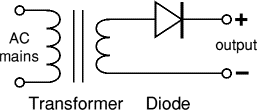
Figure 1
Power supplies are devices accustomed to provide electrical or other sort of energy to a load or cluster of load. A type of power supply that makes use of a transformer is the AC powered linear power supply. The voltage from the wall socket is converted by the transformer to produce a normally lower voltage. Switched-mode and AC/DC power supplies are the types that does not utilize the presence of transformers. These transformers are responsible for transmitting electrical supply from one circuit to another through its coils (windings).
Designing a transformerless power supply makes it more suitable for smaller installations, in any location, where the area may be limited. The circuit can manage the high current coming from the mains by supplying 12 Volts at 20mA. The reason behind using capacitive reactance rather than resistance is the fact the the type of current flowing into the circuit is alternating. It can also be used with fluctuating DC supply. The reactance adapts with the way the components react in the circuit in terms of frequencies. A fusible resistor can also be used to provide more safety.
As an output device, optical sensors are preferred by measuring the intensity change of light when the power is increased among other controllers like temperature controllers, light switches or timers. The capacitor C1 are connected across the mains supply to act as restrainer. These capacitors are usually tagged with safety standard measures, although they are usually more expensive type rather than ordinary capacitors. Placing two capacitors in parallel or increasing the value can give way to additional current. The two zener diodes are responsible for supplying the low voltage because these types of diodes controls the output by setting their breakdown or desired voltage, as they flow to the rectifier. The rectifier is responsible for converting the AC to DC. Opposite conversion form DC to AC uses an inverter. If the circuit would require an output higher than 40mA, transformers would be more significant to use.
The comparison between transformerless and transformer-based power supplies is not easy to identify due to the technologies that each one offers in the market. But the primary difference between the two are the physical dimension, noise, efficiency and the intensity of harmonic distortion that they produce.













Tiada ulasan:
Catat Ulasan